FNCE5014 - Corporate Finance for Managers Assignment - Trimester 3
VerifiedAdded on 2022/10/19
|10
|1505
|370
Homework Assignment
AI Summary
This assignment solution addresses key concepts in corporate finance, including the time value of money, bond valuation, and stock valuation. The solution begins with calculating future values under different interest rates and compounding periods. It then proceeds to present value calculations for investment options. The assignment further explores mortgage calculations, bond pricing, and yield to maturity (YTM) computations. The solution also examines the impact of yield changes on bond returns. Finally, it delves into stock valuation using discounted cash flow analysis and the dividend discount model, calculating the required rate of return and assessing the attractiveness of a stock investment. All calculations are provided with relevant formulas and values.
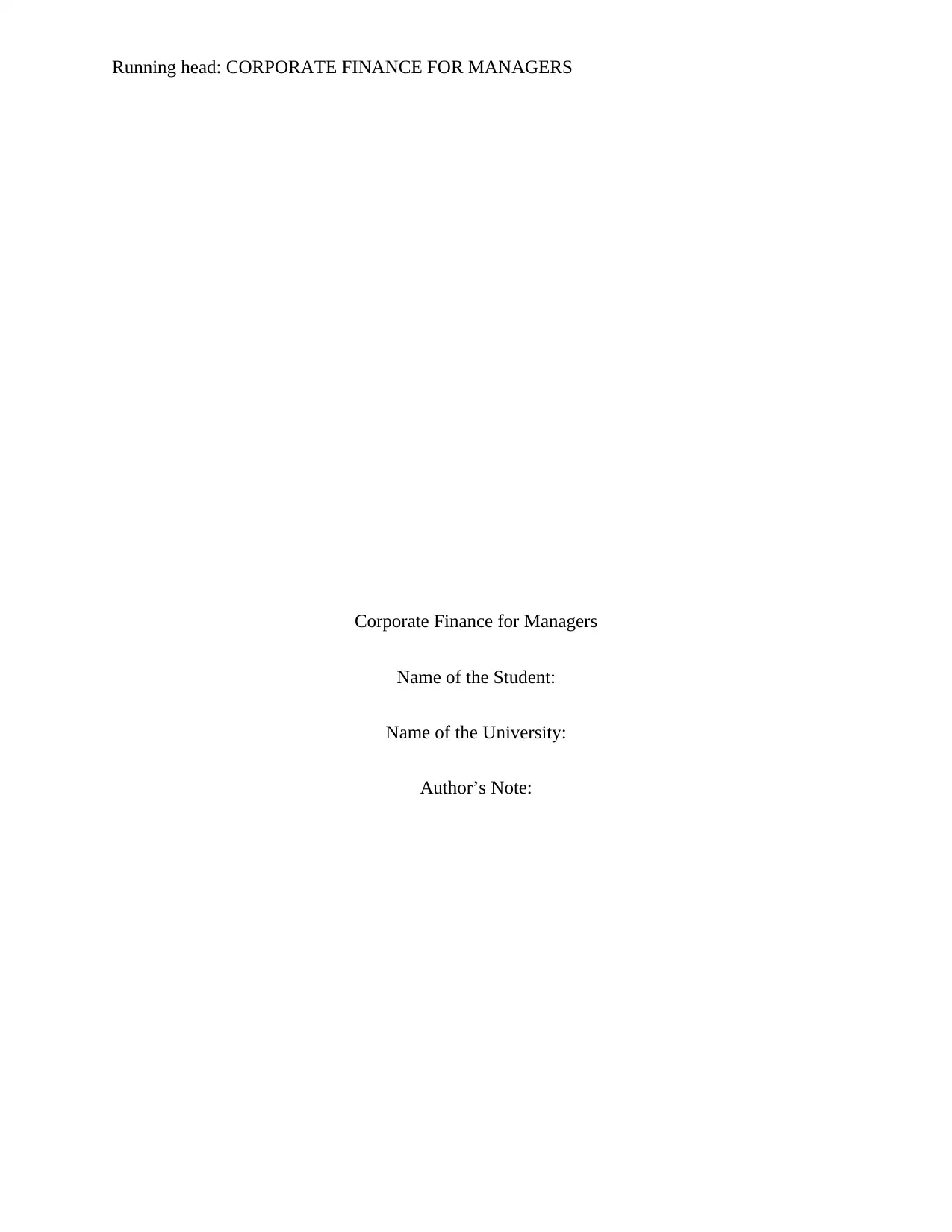
Running head: CORPORATE FINANCE FOR MANAGERS
Corporate Finance for Managers
Name of the Student:
Name of the University:
Author’s Note:
Corporate Finance for Managers
Name of the Student:
Name of the University:
Author’s Note:
Paraphrase This Document
Need a fresh take? Get an instant paraphrase of this document with our AI Paraphraser
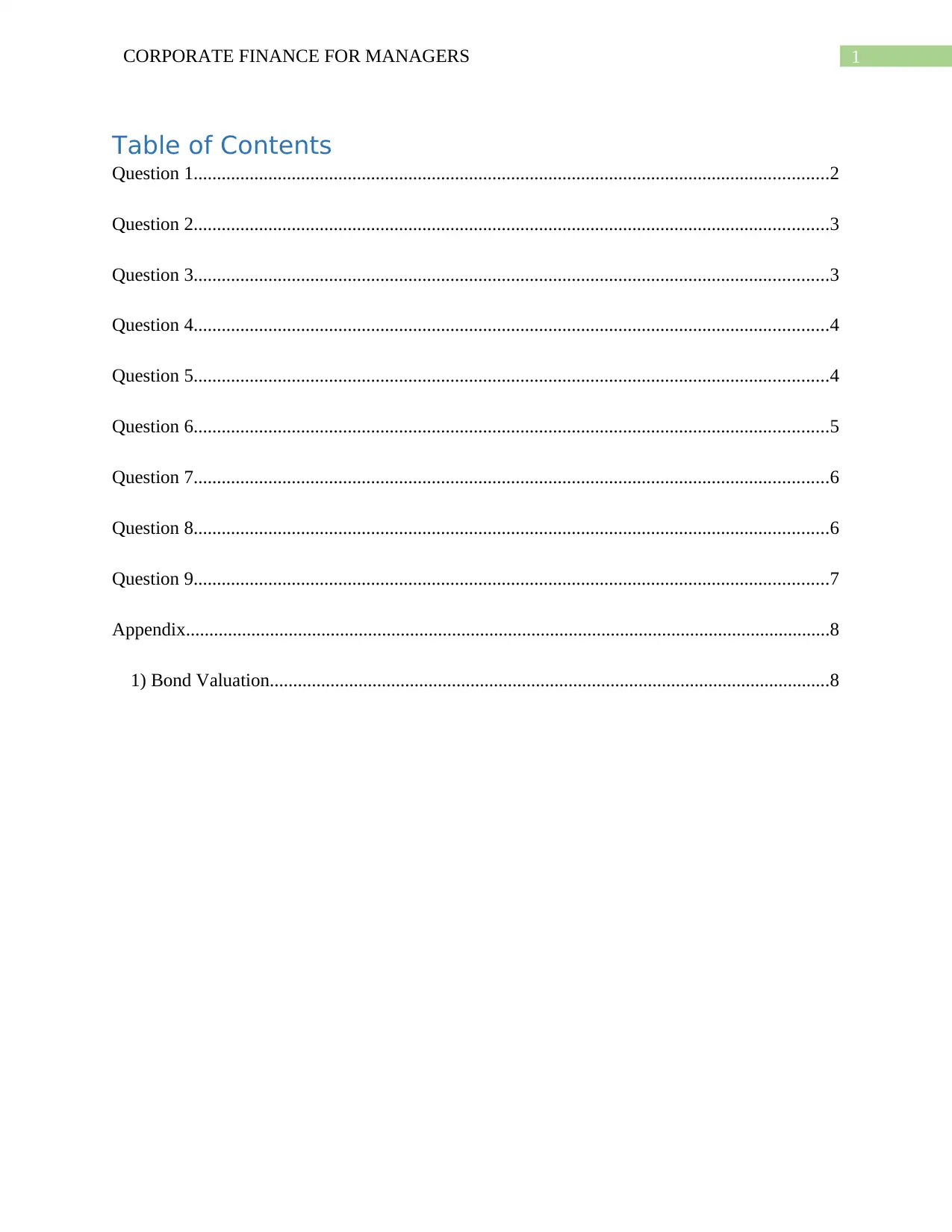
1CORPORATE FINANCE FOR MANAGERS
Table of Contents
Question 1........................................................................................................................................2
Question 2........................................................................................................................................3
Question 3........................................................................................................................................3
Question 4........................................................................................................................................4
Question 5........................................................................................................................................4
Question 6........................................................................................................................................5
Question 7........................................................................................................................................6
Question 8........................................................................................................................................6
Question 9........................................................................................................................................7
Appendix..........................................................................................................................................8
1) Bond Valuation........................................................................................................................8
Table of Contents
Question 1........................................................................................................................................2
Question 2........................................................................................................................................3
Question 3........................................................................................................................................3
Question 4........................................................................................................................................4
Question 5........................................................................................................................................4
Question 6........................................................................................................................................5
Question 7........................................................................................................................................6
Question 8........................................................................................................................................6
Question 9........................................................................................................................................7
Appendix..........................................................................................................................................8
1) Bond Valuation........................................................................................................................8

2CORPORATE FINANCE FOR MANAGERS
Question 1
The amount that would be available at the end of 32 years of age would be calculated
with the help of the initial amount invested at the specified rate of interest rate level for the
company that would be primarily in the two stages where the interest rate at the first stage would
be taken at 6.5% p.a compounded semi-annually. On the other hand, in the second stage of
investment the interest rate that would be taken into consideration would be around 3%. The
amount derived after the first age of investment in the 18-years of time frame will be around
$1,581.29, which is calculated as follows:
First Phase of Investment
Initial Investment 500
Interest Rate 6.50%
Compounding Period Semi-Annually
Time Period (In Years) 18
Formula =FV(B3/2,B5*2,0,-B2,0)
Future Value $1,581.29
In the second phase of investment where the interest rate would be around 3% on an annual basis
the future value of the sum of investment would be around $2391.85.
Second Phase of Investment
Amount After 18 Years $1,581.29
Interest Rate 3.00%
Compounding Period Annually
Time Period (In Years) 14
Formula =FV(B10,B12,0,-B9,0)
Total Future Value $2,391.85
Question 1
The amount that would be available at the end of 32 years of age would be calculated
with the help of the initial amount invested at the specified rate of interest rate level for the
company that would be primarily in the two stages where the interest rate at the first stage would
be taken at 6.5% p.a compounded semi-annually. On the other hand, in the second stage of
investment the interest rate that would be taken into consideration would be around 3%. The
amount derived after the first age of investment in the 18-years of time frame will be around
$1,581.29, which is calculated as follows:
First Phase of Investment
Initial Investment 500
Interest Rate 6.50%
Compounding Period Semi-Annually
Time Period (In Years) 18
Formula =FV(B3/2,B5*2,0,-B2,0)
Future Value $1,581.29
In the second phase of investment where the interest rate would be around 3% on an annual basis
the future value of the sum of investment would be around $2391.85.
Second Phase of Investment
Amount After 18 Years $1,581.29
Interest Rate 3.00%
Compounding Period Annually
Time Period (In Years) 14
Formula =FV(B10,B12,0,-B9,0)
Total Future Value $2,391.85
⊘ This is a preview!⊘
Do you want full access?
Subscribe today to unlock all pages.

Trusted by 1+ million students worldwide

3CORPORATE FINANCE FOR MANAGERS
Question 2
In order to value the best option available for the investor to consider the annual payment
that would be received by the investor would be compared on a present value basis with the help
of the prevailing 4.25% interest rate. In the first case the present value generated is around
$59,974.04 and in the second case the present value of investment will be around $68,827.59.
First Option
Annual Amount 9000
Time Period 8
Interest Rate 4.25%
Formula =PV(B19,B18,B17,0,0)
Present Value ($59,974.04)
Second Option
Annual Amount 7000
Time Period 13
Interest Rate 4.25%
Formula =PV(B26,B25,B24,0,0)
Present Value ($68,827.59)
Question 3
The monthly mortgage amount for the investor in the 30 year loan where the monthly
interest rate applicable is around 0.75% then the annuity amount would be around $804.62.
Monthly Mortgage Value
Mortgage Value 100000
Time Period 30
Payment Frequency Monthly
Interest Rate 0.75%
Formula =PMT(F5,F3*12,-F2,0,0)
PMT $804.62
Question 2
In order to value the best option available for the investor to consider the annual payment
that would be received by the investor would be compared on a present value basis with the help
of the prevailing 4.25% interest rate. In the first case the present value generated is around
$59,974.04 and in the second case the present value of investment will be around $68,827.59.
First Option
Annual Amount 9000
Time Period 8
Interest Rate 4.25%
Formula =PV(B19,B18,B17,0,0)
Present Value ($59,974.04)
Second Option
Annual Amount 7000
Time Period 13
Interest Rate 4.25%
Formula =PV(B26,B25,B24,0,0)
Present Value ($68,827.59)
Question 3
The monthly mortgage amount for the investor in the 30 year loan where the monthly
interest rate applicable is around 0.75% then the annuity amount would be around $804.62.
Monthly Mortgage Value
Mortgage Value 100000
Time Period 30
Payment Frequency Monthly
Interest Rate 0.75%
Formula =PMT(F5,F3*12,-F2,0,0)
PMT $804.62
Paraphrase This Document
Need a fresh take? Get an instant paraphrase of this document with our AI Paraphraser
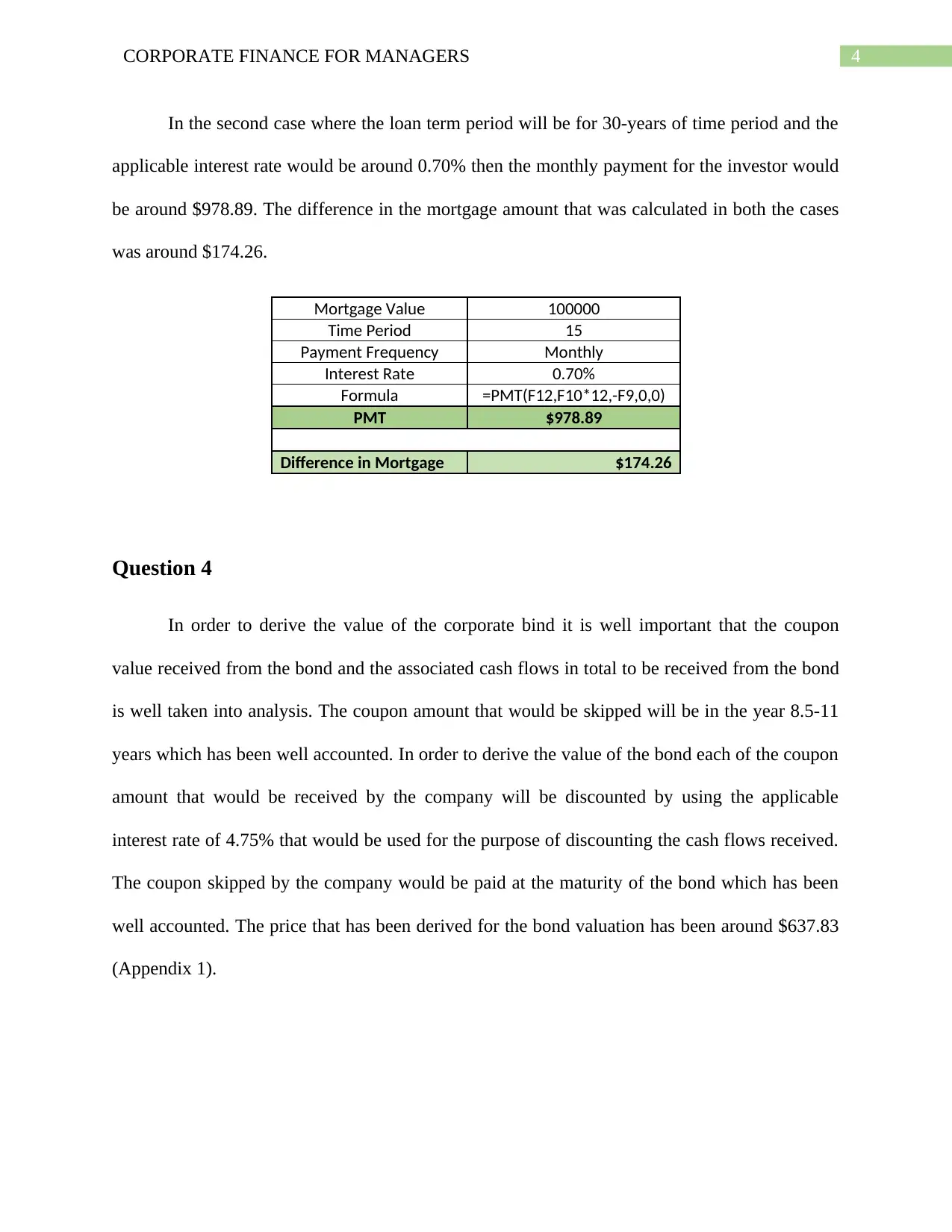
4CORPORATE FINANCE FOR MANAGERS
In the second case where the loan term period will be for 30-years of time period and the
applicable interest rate would be around 0.70% then the monthly payment for the investor would
be around $978.89. The difference in the mortgage amount that was calculated in both the cases
was around $174.26.
Mortgage Value 100000
Time Period 15
Payment Frequency Monthly
Interest Rate 0.70%
Formula =PMT(F12,F10*12,-F9,0,0)
PMT $978.89
Difference in Mortgage $174.26
Question 4
In order to derive the value of the corporate bind it is well important that the coupon
value received from the bond and the associated cash flows in total to be received from the bond
is well taken into analysis. The coupon amount that would be skipped will be in the year 8.5-11
years which has been well accounted. In order to derive the value of the bond each of the coupon
amount that would be received by the company will be discounted by using the applicable
interest rate of 4.75% that would be used for the purpose of discounting the cash flows received.
The coupon skipped by the company would be paid at the maturity of the bond which has been
well accounted. The price that has been derived for the bond valuation has been around $637.83
(Appendix 1).
In the second case where the loan term period will be for 30-years of time period and the
applicable interest rate would be around 0.70% then the monthly payment for the investor would
be around $978.89. The difference in the mortgage amount that was calculated in both the cases
was around $174.26.
Mortgage Value 100000
Time Period 15
Payment Frequency Monthly
Interest Rate 0.70%
Formula =PMT(F12,F10*12,-F9,0,0)
PMT $978.89
Difference in Mortgage $174.26
Question 4
In order to derive the value of the corporate bind it is well important that the coupon
value received from the bond and the associated cash flows in total to be received from the bond
is well taken into analysis. The coupon amount that would be skipped will be in the year 8.5-11
years which has been well accounted. In order to derive the value of the bond each of the coupon
amount that would be received by the company will be discounted by using the applicable
interest rate of 4.75% that would be used for the purpose of discounting the cash flows received.
The coupon skipped by the company would be paid at the maturity of the bond which has been
well accounted. The price that has been derived for the bond valuation has been around $637.83
(Appendix 1).

5CORPORATE FINANCE FOR MANAGERS
Question 5
The YTM for the bond has been calculated with the help of the future value of the bind
which is $1000, Current price that is $1080, Coupon Rate of 4% and payment frequency of about
semi-annually. The YTM of the bond was calculated to be around 3.19% with the given set of
information, the time period was multiplied by the payment frequency and the applicable interest
rate was divided by the payment frequency which is around 2 times.
Question 6
The key assumption that has been made while valuing the bond has been the face value of
the bond that has been kept at $1000, the applicable interest rate taken for the purpose of
determining the present value is around 7.50% compounded on a semi-annually basis and the
coupon rate taken into consideration is around 6%. The present value of the bond was
determined to be around $895.78.
Face Value 1000
Coupon Rate 6%
Payment
Frequency Semi-Annually
Compounded Yield 7.50%
YTM Calculations
Face Value 1000
Time Period 12
Coupon Rate 4%
Payment
Frequency Semi-Annually
Current Price 1080
YTM 3.19%
Formula =(RATE(Q3*2,(Q2*Q4)/2,-Q6,Q2,0,5%))*2
Question 5
The YTM for the bond has been calculated with the help of the future value of the bind
which is $1000, Current price that is $1080, Coupon Rate of 4% and payment frequency of about
semi-annually. The YTM of the bond was calculated to be around 3.19% with the given set of
information, the time period was multiplied by the payment frequency and the applicable interest
rate was divided by the payment frequency which is around 2 times.
Question 6
The key assumption that has been made while valuing the bond has been the face value of
the bond that has been kept at $1000, the applicable interest rate taken for the purpose of
determining the present value is around 7.50% compounded on a semi-annually basis and the
coupon rate taken into consideration is around 6%. The present value of the bond was
determined to be around $895.78.
Face Value 1000
Coupon Rate 6%
Payment
Frequency Semi-Annually
Compounded Yield 7.50%
YTM Calculations
Face Value 1000
Time Period 12
Coupon Rate 4%
Payment
Frequency Semi-Annually
Current Price 1080
YTM 3.19%
Formula =(RATE(Q3*2,(Q2*Q4)/2,-Q6,Q2,0,5%))*2
⊘ This is a preview!⊘
Do you want full access?
Subscribe today to unlock all pages.

Trusted by 1+ million students worldwide

6CORPORATE FINANCE FOR MANAGERS
Time Period 10
Present Value ($895.78)
Formula =PV(Q14/2,Q15*2,(Q11*Q12)/2,Q11,0)
Question 7
In order to calculate the return generated by the investor when the yield changes for a bond
it is important to determine the price for the bond under both the conditions. In the first case by
taking the current yield, coupon bond, future value and the time period the price of the bond was
determined to be around $1077.22. However, it is important to note that as the yield rise the bond
price falls and the same was determined when the interest rate yield changed from 6% to around
5% for the bond market and the investor generated an negative return of about -7.17%.
Return Generated
Coupon Rate 6%
Face Value 1000
Time 10
YTM 5%
Price ($1,077.22)
Coupon Rate 6%
Face Value 1000
Time 10
YTM 6%
Price ($1,000.00)
Return -7.17%
Question 8
The value of the stock has been determined with the help of the discounted cash flow basis
whereby the growth rate that would be applicable for the purpose of growing of dividend of the
company has been around 2% and the terminal growth rate applicable for the share valuation has
Time Period 10
Present Value ($895.78)
Formula =PV(Q14/2,Q15*2,(Q11*Q12)/2,Q11,0)
Question 7
In order to calculate the return generated by the investor when the yield changes for a bond
it is important to determine the price for the bond under both the conditions. In the first case by
taking the current yield, coupon bond, future value and the time period the price of the bond was
determined to be around $1077.22. However, it is important to note that as the yield rise the bond
price falls and the same was determined when the interest rate yield changed from 6% to around
5% for the bond market and the investor generated an negative return of about -7.17%.
Return Generated
Coupon Rate 6%
Face Value 1000
Time 10
YTM 5%
Price ($1,077.22)
Coupon Rate 6%
Face Value 1000
Time 10
YTM 6%
Price ($1,000.00)
Return -7.17%
Question 8
The value of the stock has been determined with the help of the discounted cash flow basis
whereby the growth rate that would be applicable for the purpose of growing of dividend of the
company has been around 2% and the terminal growth rate applicable for the share valuation has
Paraphrase This Document
Need a fresh take? Get an instant paraphrase of this document with our AI Paraphraser
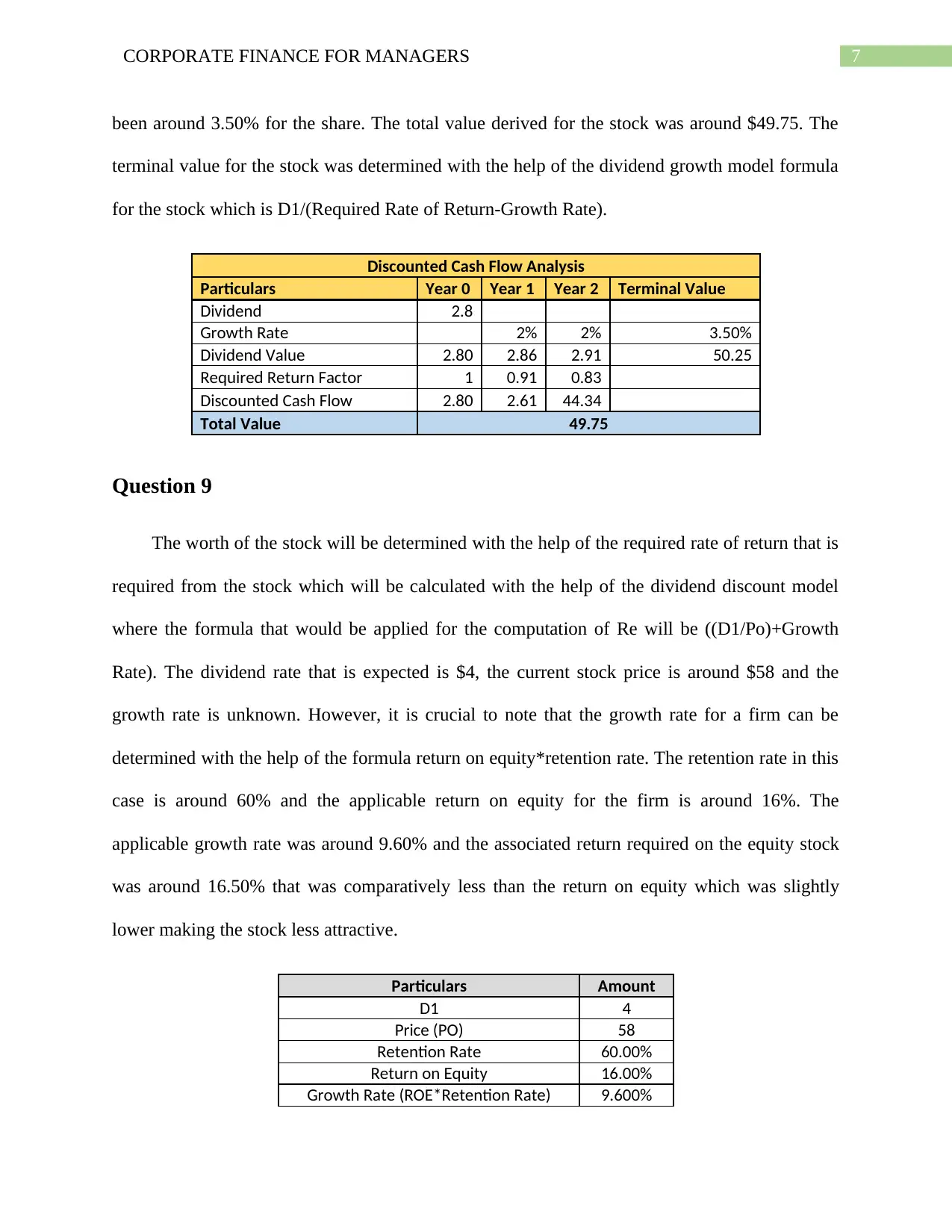
7CORPORATE FINANCE FOR MANAGERS
been around 3.50% for the share. The total value derived for the stock was around $49.75. The
terminal value for the stock was determined with the help of the dividend growth model formula
for the stock which is D1/(Required Rate of Return-Growth Rate).
Discounted Cash Flow Analysis
Particulars Year 0 Year 1 Year 2 Terminal Value
Dividend 2.8
Growth Rate 2% 2% 3.50%
Dividend Value 2.80 2.86 2.91 50.25
Required Return Factor 1 0.91 0.83
Discounted Cash Flow 2.80 2.61 44.34
Total Value 49.75
Question 9
The worth of the stock will be determined with the help of the required rate of return that is
required from the stock which will be calculated with the help of the dividend discount model
where the formula that would be applied for the computation of Re will be ((D1/Po)+Growth
Rate). The dividend rate that is expected is $4, the current stock price is around $58 and the
growth rate is unknown. However, it is crucial to note that the growth rate for a firm can be
determined with the help of the formula return on equity*retention rate. The retention rate in this
case is around 60% and the applicable return on equity for the firm is around 16%. The
applicable growth rate was around 9.60% and the associated return required on the equity stock
was around 16.50% that was comparatively less than the return on equity which was slightly
lower making the stock less attractive.
Particulars Amount
D1 4
Price (PO) 58
Retention Rate 60.00%
Return on Equity 16.00%
Growth Rate (ROE*Retention Rate) 9.600%
been around 3.50% for the share. The total value derived for the stock was around $49.75. The
terminal value for the stock was determined with the help of the dividend growth model formula
for the stock which is D1/(Required Rate of Return-Growth Rate).
Discounted Cash Flow Analysis
Particulars Year 0 Year 1 Year 2 Terminal Value
Dividend 2.8
Growth Rate 2% 2% 3.50%
Dividend Value 2.80 2.86 2.91 50.25
Required Return Factor 1 0.91 0.83
Discounted Cash Flow 2.80 2.61 44.34
Total Value 49.75
Question 9
The worth of the stock will be determined with the help of the required rate of return that is
required from the stock which will be calculated with the help of the dividend discount model
where the formula that would be applied for the computation of Re will be ((D1/Po)+Growth
Rate). The dividend rate that is expected is $4, the current stock price is around $58 and the
growth rate is unknown. However, it is crucial to note that the growth rate for a firm can be
determined with the help of the formula return on equity*retention rate. The retention rate in this
case is around 60% and the applicable return on equity for the firm is around 16%. The
applicable growth rate was around 9.60% and the associated return required on the equity stock
was around 16.50% that was comparatively less than the return on equity which was slightly
lower making the stock less attractive.
Particulars Amount
D1 4
Price (PO) 58
Retention Rate 60.00%
Return on Equity 16.00%
Growth Rate (ROE*Retention Rate) 9.600%

8CORPORATE FINANCE FOR MANAGERS
Required Rate of Return ((D1/Po)+g) 16.50%
Required Rate of Return ((D1/Po)+g) 16.50%
⊘ This is a preview!⊘
Do you want full access?
Subscribe today to unlock all pages.

Trusted by 1+ million students worldwide
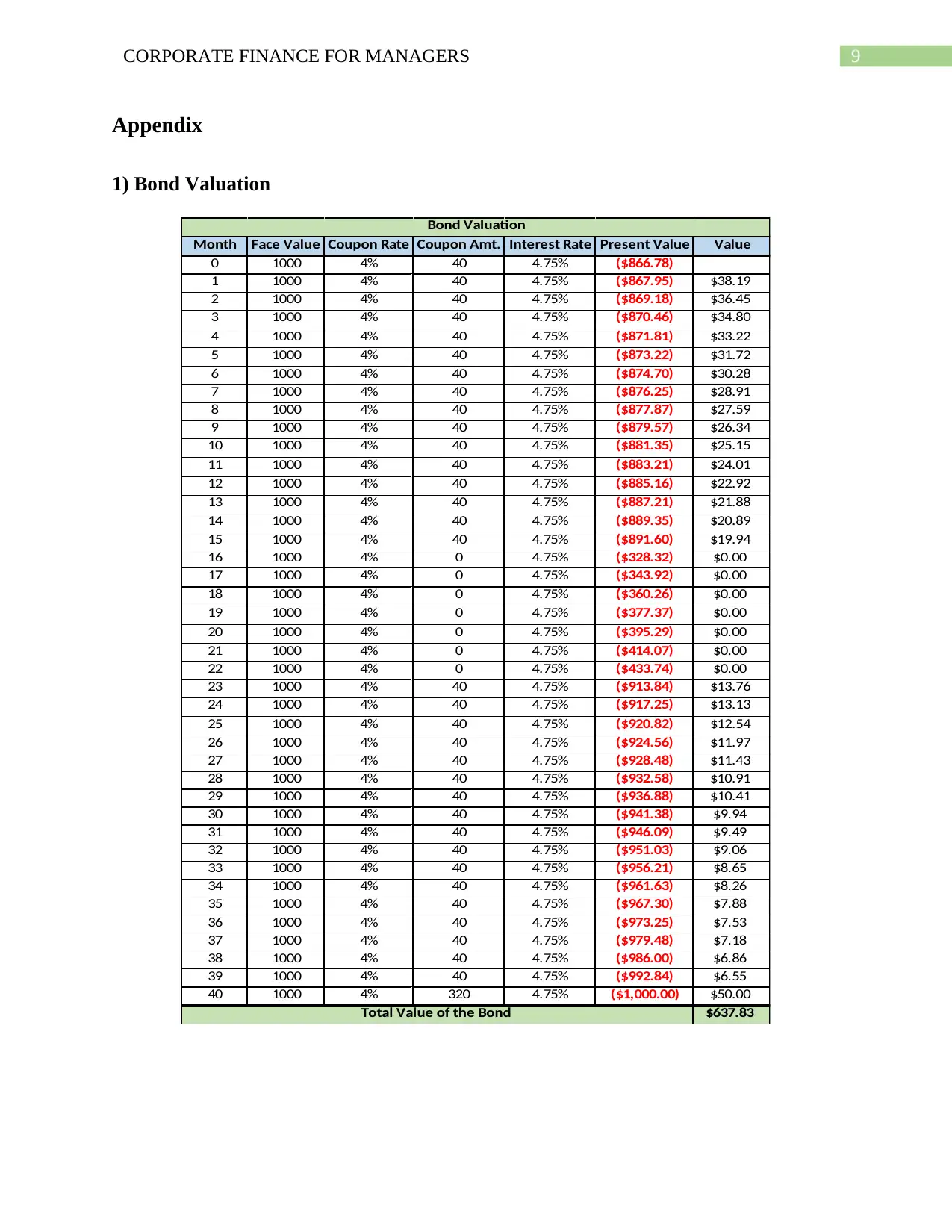
9CORPORATE FINANCE FOR MANAGERS
Appendix
1) Bond Valuation
Month Face Value Coupon Rate Coupon Amt. Interest Rate Present Value Value
0 1000 4% 40 4.75% ($866.78)
1 1000 4% 40 4.75% ($867.95) $38.19
2 1000 4% 40 4.75% ($869.18) $36.45
3 1000 4% 40 4.75% ($870.46) $34.80
4 1000 4% 40 4.75% ($871.81) $33.22
5 1000 4% 40 4.75% ($873.22) $31.72
6 1000 4% 40 4.75% ($874.70) $30.28
7 1000 4% 40 4.75% ($876.25) $28.91
8 1000 4% 40 4.75% ($877.87) $27.59
9 1000 4% 40 4.75% ($879.57) $26.34
10 1000 4% 40 4.75% ($881.35) $25.15
11 1000 4% 40 4.75% ($883.21) $24.01
12 1000 4% 40 4.75% ($885.16) $22.92
13 1000 4% 40 4.75% ($887.21) $21.88
14 1000 4% 40 4.75% ($889.35) $20.89
15 1000 4% 40 4.75% ($891.60) $19.94
16 1000 4% 0 4.75% ($328.32) $0.00
17 1000 4% 0 4.75% ($343.92) $0.00
18 1000 4% 0 4.75% ($360.26) $0.00
19 1000 4% 0 4.75% ($377.37) $0.00
20 1000 4% 0 4.75% ($395.29) $0.00
21 1000 4% 0 4.75% ($414.07) $0.00
22 1000 4% 0 4.75% ($433.74) $0.00
23 1000 4% 40 4.75% ($913.84) $13.76
24 1000 4% 40 4.75% ($917.25) $13.13
25 1000 4% 40 4.75% ($920.82) $12.54
26 1000 4% 40 4.75% ($924.56) $11.97
27 1000 4% 40 4.75% ($928.48) $11.43
28 1000 4% 40 4.75% ($932.58) $10.91
29 1000 4% 40 4.75% ($936.88) $10.41
30 1000 4% 40 4.75% ($941.38) $9.94
31 1000 4% 40 4.75% ($946.09) $9.49
32 1000 4% 40 4.75% ($951.03) $9.06
33 1000 4% 40 4.75% ($956.21) $8.65
34 1000 4% 40 4.75% ($961.63) $8.26
35 1000 4% 40 4.75% ($967.30) $7.88
36 1000 4% 40 4.75% ($973.25) $7.53
37 1000 4% 40 4.75% ($979.48) $7.18
38 1000 4% 40 4.75% ($986.00) $6.86
39 1000 4% 40 4.75% ($992.84) $6.55
40 1000 4% 320 4.75% ($1,000.00) $50.00
$637.83Total Value of the Bond
Bond Valuation
Appendix
1) Bond Valuation
Month Face Value Coupon Rate Coupon Amt. Interest Rate Present Value Value
0 1000 4% 40 4.75% ($866.78)
1 1000 4% 40 4.75% ($867.95) $38.19
2 1000 4% 40 4.75% ($869.18) $36.45
3 1000 4% 40 4.75% ($870.46) $34.80
4 1000 4% 40 4.75% ($871.81) $33.22
5 1000 4% 40 4.75% ($873.22) $31.72
6 1000 4% 40 4.75% ($874.70) $30.28
7 1000 4% 40 4.75% ($876.25) $28.91
8 1000 4% 40 4.75% ($877.87) $27.59
9 1000 4% 40 4.75% ($879.57) $26.34
10 1000 4% 40 4.75% ($881.35) $25.15
11 1000 4% 40 4.75% ($883.21) $24.01
12 1000 4% 40 4.75% ($885.16) $22.92
13 1000 4% 40 4.75% ($887.21) $21.88
14 1000 4% 40 4.75% ($889.35) $20.89
15 1000 4% 40 4.75% ($891.60) $19.94
16 1000 4% 0 4.75% ($328.32) $0.00
17 1000 4% 0 4.75% ($343.92) $0.00
18 1000 4% 0 4.75% ($360.26) $0.00
19 1000 4% 0 4.75% ($377.37) $0.00
20 1000 4% 0 4.75% ($395.29) $0.00
21 1000 4% 0 4.75% ($414.07) $0.00
22 1000 4% 0 4.75% ($433.74) $0.00
23 1000 4% 40 4.75% ($913.84) $13.76
24 1000 4% 40 4.75% ($917.25) $13.13
25 1000 4% 40 4.75% ($920.82) $12.54
26 1000 4% 40 4.75% ($924.56) $11.97
27 1000 4% 40 4.75% ($928.48) $11.43
28 1000 4% 40 4.75% ($932.58) $10.91
29 1000 4% 40 4.75% ($936.88) $10.41
30 1000 4% 40 4.75% ($941.38) $9.94
31 1000 4% 40 4.75% ($946.09) $9.49
32 1000 4% 40 4.75% ($951.03) $9.06
33 1000 4% 40 4.75% ($956.21) $8.65
34 1000 4% 40 4.75% ($961.63) $8.26
35 1000 4% 40 4.75% ($967.30) $7.88
36 1000 4% 40 4.75% ($973.25) $7.53
37 1000 4% 40 4.75% ($979.48) $7.18
38 1000 4% 40 4.75% ($986.00) $6.86
39 1000 4% 40 4.75% ($992.84) $6.55
40 1000 4% 320 4.75% ($1,000.00) $50.00
$637.83Total Value of the Bond
Bond Valuation
1 out of 10
Related Documents
Your All-in-One AI-Powered Toolkit for Academic Success.
+13062052269
info@desklib.com
Available 24*7 on WhatsApp / Email
![[object Object]](/_next/static/media/star-bottom.7253800d.svg)
Unlock your academic potential
Copyright © 2020–2025 A2Z Services. All Rights Reserved. Developed and managed by ZUCOL.





